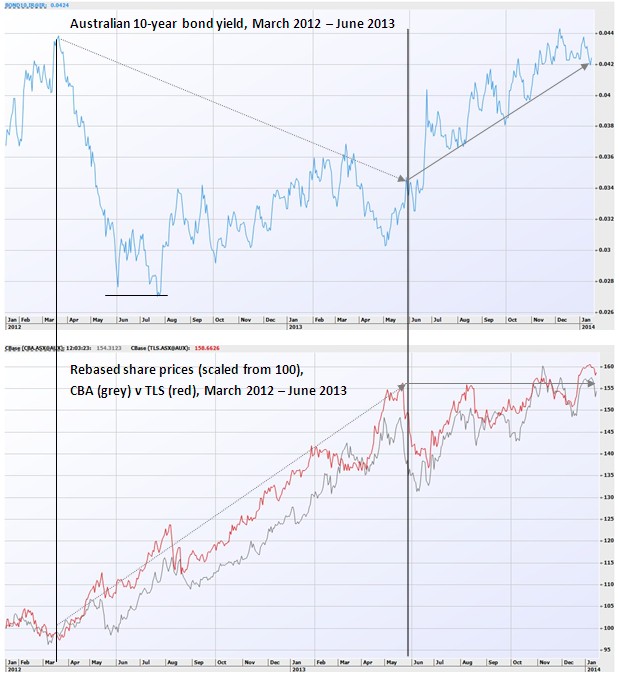
Muted Returns
In the early stages of 2012 – and in reaction to the challenges the Australian economy was potentially facing – the Reserve Bank of Australia adopted an aggressive easing bias towards monetary policy. What followed was a period of extremely aggressive interest rate cuts and the yield on Australia’s 10-year government bonds fell from 4.4 per cent to the historical low of 2.5 per cent just a few months later.
The goal was simple: to steer investors back to risk assets such as property and shares, and create what is known as the “wealth effect”. This would see prices rise, confidence restored, people consuming and borrowing more, and businesses investing and hiring again. Somewhat knowingly, the RBA set-off what has been since been termed “the chase for yield”.
In a world of central bank-inflated asset prices, investors were literally driven out of the safety of cash deposits and given the poor returns on offer. Charted on the same axis, CBA and TLS increased pretty much lock, stock and barrel to end up almost 50 per cent higher over the 15-month period to June 2013. This is a rare and rather odd occurrence, as I’m sure you would agree. Indeed, if you were a listed business able to show a stable dividend yield, then the chances were that a term deposit was somewhere exchanged for a part-interest in your businesses. If this was the case, the price of your business would have been driven to a historically high valuation.
In our opinion, that has resulted in share prices moving well in advance of earnings over the same period as what is being discussed here, since the earnings growth for CBA and TLS, for example, has been subdued. The expansion of price/earnings ratios (based on prices increasing) without the associated earnings growth is what we’d consider to be a risky investment strategy. Over long periods of time, share prices are ultimately driven by the future earnings power and growth of a business, not by the chase for yield.
Despite their blue chip status and relatively stable and predictable earnings of businesses such as CBA and TLS, the fact they are trading at inflated prices due to subdued earnings growth, has, in our opinion, made them far riskier investment propositions.
This holds true especially if cash rates begin to rise, which – if the recent rise in bond yields is anything to go by – might not be that far away. Yields on 10-year government bonds are back at levels not seen since early 2012. Given the reliability of the bond market in predicting cash rate moves, the next one could be very well be up.
The implication of this should be pretty obvious, and perhaps the share prices of CBA and TLS since May 2013 (the same period over which bond yields have climbed precipitously back to over 4 per cent), have largely remained unchanged. It therefore appears that the easy returns have already been made, and unless earnings growth now eventuates for a number of businesses, then going forward – investors who have high weightings to yield-driven stocks may become somewhat disappointed with their returns.
An alternative of course is to find quality businesses – those that have high rates of return on equity, the ability to continue to deploy capital profitably, sound balance sheets and bright prospects for future earnings growth. It’s exactly this that the team at Montgomery focuses on.
This post was contributed by a representative of Montgomery Investment Management Pty Limited (AFSL No. 354564). The principal purpose of this post is to provide factual information and not provide financial product advice. Additionally, the information provided is not intended to provide any recommendation or opinion about any financial product. Any commentary and statements of opinion however may contain general advice only that is prepared without taking into account your personal objectives, financial circumstances or needs. Because of this, before acting on any of the information provided, you should always consider its appropriateness in light of your personal objectives, financial circumstances and needs and should consider seeking independent advice from a financial advisor if necessary before making any decisions. This post specifically excludes personal advice.
INVEST WITH MONTGOMERY
QE2 has taught me many things. Printing money doesn’t necessarily create inflation, as many people think. Inflation is created when this printed money is released into the economy. And it is being released slowly through the banks. That is why we haven’t seen inflation YET.
2013 was a good year for investors helped by quantitative easing. House prices were up because of quantitative easing. Asset prices in general were up because of quantitative easing. But this hasn’t brought in as much confidence as the government would of hoped.
The costs of quantitative easing are a deflated currency, this has happened in USA and UK. And because of the deflated currency, it increased the real value debt of the country. Australia has avoided this so far.
There has been a chase for yield and the number of IPO’s are up as has the number of junk bonds, all because of quantitative easing.
If the trend continues of low interest rates on term deposits pushing people to into buying up shares in “blue chip”, “stable”, “high yield” companied then where to next after the yield on these companies reduces to a level that is no longer attractive?
Either way, as you say, these types of companies are looking far more riskier as a result of what is an investment philosophy removed from the business fundamentals and focusing on a more macro theme. These companies tend to be mature so will unlikely have the growth rates to match the implied levels of the stock price.
All of this, leads to a feeling of an impending correction to me, the only uncertainty is when, what is the catalyst and the extent of the reaction by investors/market.
Was it CBA that saw a small sell off when they didn’t announce a special dividend?
It is all just starting to look a little irrational although probably not at “crazy impulsiveness” yet which tends to trigger a significant event that brings value investors well and truly into the game as greed and/or fear dominate.
ANZ which you own has had a similar trend to CBA and TLS which you also mention. Why do you then continue to hold ANZ if their P/E ratio has also grown faster than their EPS and run ahead of itself?